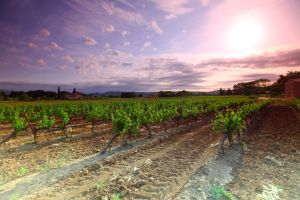It’s all about that CLORPT
December 11, 2014 5 Comments
It happened again. All I really wanted to do was to get a quick, google-assisted definition of the word “colluvial.” I had read somewhere (the particular book, magazine, or webpage long since totally forgotten) that many of the soils in Alsace were colluvial.
Colluvial soils, it turns out, are made up of materials that tend to accumulate at the bottom of steep slopes and cliffs, mainly via the action of gravity – as opposed to alluvial soils, which accumulate due to the action of rivers and streams.
But here’s what I also found out…we are living in the pedosphere! The pedosphere, which rests above the lithosphere (basically the earth’s crust and mantle) but below the atmosphere, is the outermost layer of the earth. It is where soil lives, and where soil is formed, via the weathering (breaking down) of minerals, the decomposition of organic matter, and everything moving around (as in living things moving around, as well as -ahem – colluvial and alluvial actions). The pedosphere is the foundation of all plant life (and therefore animal life) on the planet. And here we thought it was all about the specific flavor of Riesling from the Haut-Rhin!
Soil has Texture
Here’s something else I learned: soil has texture. Good students of wine most likely know that the particles that make up soil are categorized by size, with clay being the smallest, silt the intermediate, and sand the largest. The blend, so to speak, of the particles is what makes up a soil’s “texture.” There are actually 12 major soil classifications, as defined by the USDA. Some of these, such as “sandy clay” or “silty clay” are self-explanatory; while “loam” is made up of somewhat equal parts of sand, silt, and clay.
Soil has Color
We know about bright-red terra rosa and glistening gray llicorella, so it shouldn’t come as a big surprise that the color of soil varies according to mineral content, organic material, and water. That lovely orange/brown color signals high iron content. Dark brown or black soils are high in organic material. A well-drained soil is brightly colored, while a poorly drained soil will show an uneven pattern of red, yellow, and gray.
Soil has Structure.
Is this beginning to sound a bit like wine? Color, texture, structure? Perhaps that’s a stretch – but you have to admit all things are connected. The structure of soil relates to how the soil particles arrange themselves into small clumps, called “peds.” Peds vary due to the nature of the particles themselves and the conditions under which they were formed. For instance, getting wet and drying out, freezing and thawing, being walked on, having things grown in it, and/or being moved around can all influence the nature of the peds.
There are six basic ways to describe soil’s structure, based on how these peds interplay. They are: platy, prismatic, columnar, blocky, granular, and single-grained. Platy soil is thin and flat; sometimes the result of being walked on or otherwise compacted. Prismatic soil is formed into columns; columnar soil is also formed into columns but with a salty “cap.” Blocky soil is irregular. Granular is crumbly, usually the result of plant growth. Single-grained soil refuses to “clump” together.
Good/Bad Dirt = Texture, Structure, and CLORPT
Soil “behaves” based on a combination of texture and structure. What a farmer might call “good soil” may be a granular soil with a loamy texture, as it holds water and nutrients. A vigneron, however, might prefer a sandy clay soil with a blocky texture, as it would be well-drained of both water and nutrients.
As for the specific soils we wine students love to talk about – jory, tufa, greywacke, marl, schist, shale, slate…they differ due to five major factors, known as CLORPT. (Now there’s a term I bet you never heard before!) CLORPT stands for climate, organisms, relief, parent material, and time – all the things that go into the various vineyard soils, all over the world, that make such tasty wine. And, lest we forget – they support all plant life and therefore animal life as well – one must eat before one can drink.
The Bubbly Professor is “Miss Jane” Nickles of Austin, Texas – missjane@prodigy.net
Note: I researched this post using about two dozen Wikipedia pages, the Soil Sciences of America Association, and the “gardening resources” page on the Cornell University website.



Well Done! I love when you geek out like this! Now the trick is will I remember it! 🙂
Hi Cristina!! Thanks so much! We geeks have got to stick together!
How I wish I could find simplified reads like this one all the time. I have had a great read. Thank you bubblyprof. It makes me love simplicity in how I do things.
Hi Rebecca! Thank you for the note and the kind words! I am so glad you enjoyed the CLORPT!!
Pingback: CLORPT: Factors Influencing Soil Formation - Angola Transparency